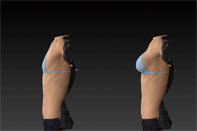Every year, the American Society of Plastic Surgeons (ASPS) and the Aesthetic Society of American Plastic Surgery (ASAPS) come out with a report that details the most popular plastic surgery trends for the year.
The results for 2018 indicate that non-invasive procedures such as Botox and Fillers are climbing exponentially in popularity. That doesn’t mean that plastic surgery is down – in fact more and more people are opting to go under the knife because the downtime for surgery is much less than it used to be.
As the years go by, technology for both invasive and non-invasive cosmetic procedures will only get better – resulting in more and more people opting to get a procedure done due to better results and less downtime.
Here are the Top Cosmetic Surgery Trends for 2018:
Non-Surgical Trends (minimally invasive)
Non-invasive procedures such as lip augmentation, Botox, and fillers have exploded in popularity. The American Society for Plastic Surgeons (ASPS) released a report in March of 2018 that listed the statistics for minimally invasive cosmetic procedures. In 2017 there were over 1.8 million cosmetic surgical procedures performed and that number is continuing to climb.
New technologies such as CoolSculpting offer a way to remove arm fat without getting surgery. The medical evidence that these technologies work well is starting to pile up and that’s causing more and more people to want to get them.
The Top 5 Non-Invasive Procedures are:
- Botox (Type A) – Used for both removing wrinkles and fine lines on the face. Botox is also showing great promise for people who suffer from certain dental issues. TMJ and gummy smiles can be corrected by the use of Botox.
- Soft tissue fillers – Soft tissue fillers are also known as “dermal fillers.” They can be used to plump up thin lips, soften facial wrinkles, improve the appearance of scars, and enhance shallow contours. Fillers are often used in conjunction with Botox to remove facial lines and wrinkles.
- Chemical peel – Long gone are the days of the painful chemical peel. New advances in technology make this procedure relatively pain-free. Chemical peels can transform the look and feel of your face.
- Laser hair removal – Laser hair removal is a non-invasive procedure that will continue to remain popular amongst both men and women. In today’s society, body hair is considered “icky” and a few laser hair removal appointments can get rid of it completely.
- Microdermabrasion – An abrasive instrument is used to gently remove dead, old skin and remove the thicker, outer layer of skin that has sun or age damage.
The amount of people getting non-invasive procedures is only expected to rise as the years go by. Non-invasive prolongs the need for many people to have to undergo the knife in order to achieve the cosmetic results that they desire.
Surgical Trends (invasive)
Surgical trends have actually increased for 2018 – despite the record amounts of people seeking non-invasive treatments. This is due in part to recent advances in surgical procedures which allow for a much shorter (and less painful) recovery time.
It can also be attributed in part to those who are initially seeking minimally-invasive procedures – only to realize these procedures can only do so much – and they will have to undergo surgery to fully achieve the look they want.
Sometimes a celebrity will also get a surgical procedure done and post before-and-after results on their social media. This in turn increases the popularity and demand of the procedure as everyone wants to look like their favorite celebrity.
Here are the Top Surgical Trends for 2018:
Vaginal rejuvenation – The stigma about vaginal rejuvenation is almost completely gone. More and more women are opting for this procedure. It can be done as a non-invasive procedure such as ThermaVa, which uses radiofrequency energy to help restore the vagina to a younger “pre-baby” stage. It can also be done as a surgical procedure such as a labiaplasty.
Breast implants – Breast implants are always going to be popular and at the top of this list. In 2017 alone, there were over 300,000 breast implant procedures performed in America. This is up 3 percent from 2016. The increase in popularity can be attributed in part to patients have less recovery time due to new surgical technologies and techniques.
Tummy Tucks – Tummy tucks are another plastic surgery staple. In 2017 there were almost 130,000 tummy tucks performed. There are many people who are unable to get rid of that last bit of belly fat – no matter how hard and long they work out. Tummy tucks offer a viable solution to this problem.
Liposuction – Liposuction is up 5 percent from 2016 as well. This could be due in part to the growing popularity of Brazilian Butt Lifts which require liposuction in order for the procedure to be successful. Many overweight people also tend to get liposuction as a way to give themselves a head start to getting that tight body they’ve always dreamed of.
Where Are the Trends Headed for 2019?
While it’s most likely that the trends will remain the same for many years to come, it’s entirely possible that new technology or a celebrity fad will cause a new procedure to increase in popularity. Kim Kardashian recently made the Vampire Facelift an overnight sensation when she posted pictures of her getting the procedure to her social media account.
Non-surgical trends will also continue to grow in popularity as well. There will be new Botox-like products on the market that offer greater results that what’s able to be achieved currently.
Cosmetic Surgery in Dallas
If you’ve been putting off getting that cosmetic procedure you’ve always wanted, now is a great time to schedule an appointment with Dr. Adams. The technology for both invasive and non-invasive procedures has improved dramatically and the overall recovery time for most procedures has decreased from just a few short years ago.















